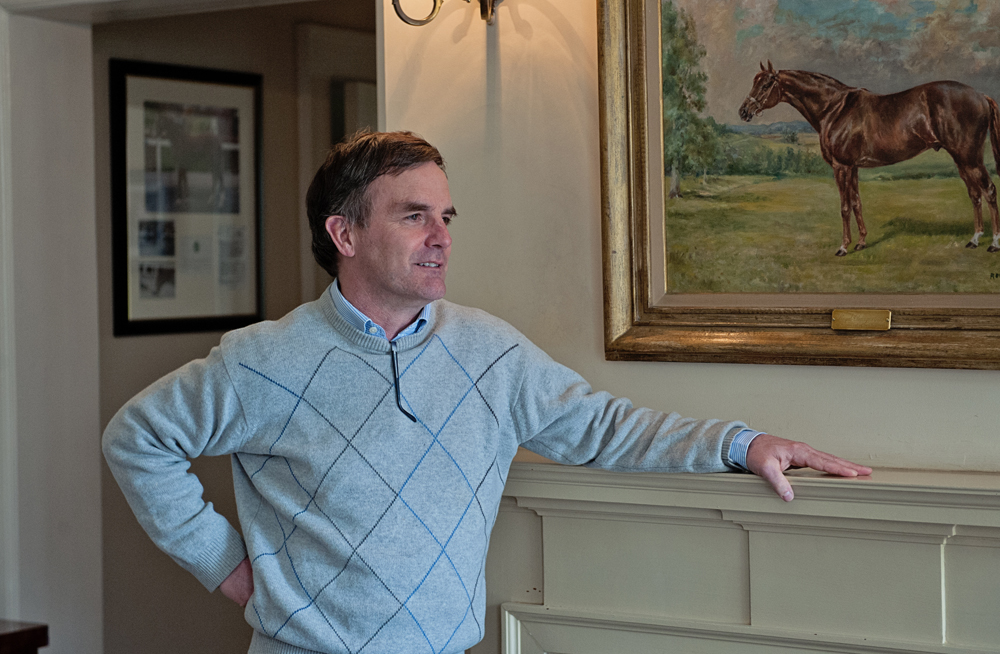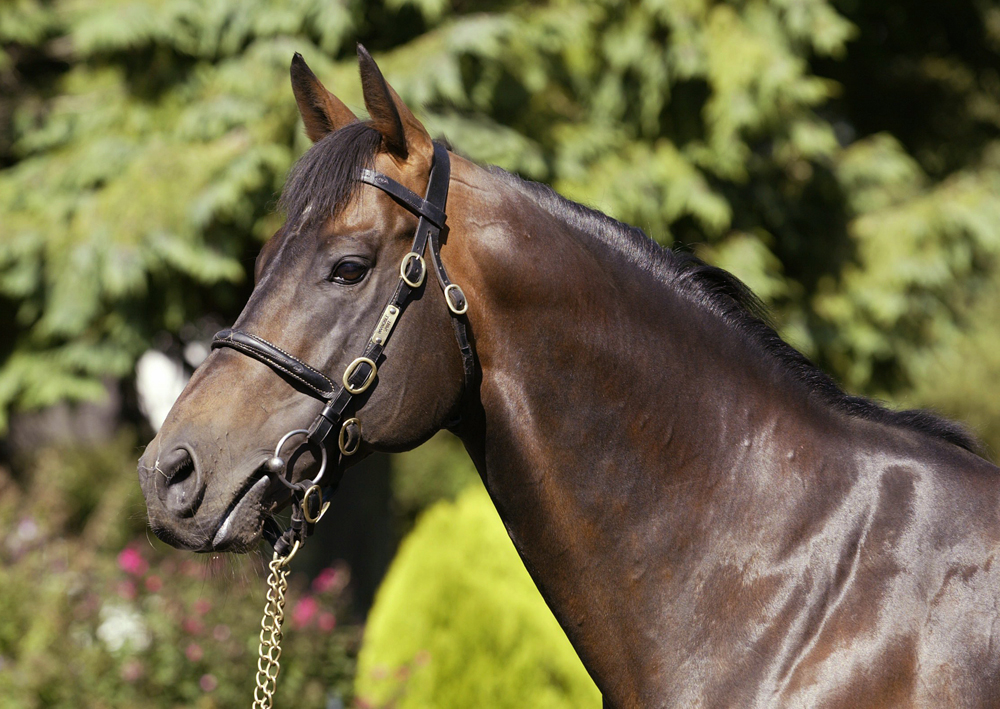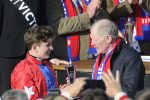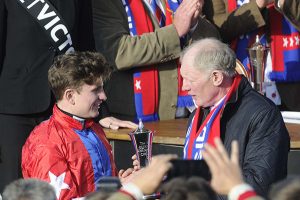When William Hall Walker gifted his bloodstock and sold his Co Kildare farm at a knockdown price to the government 100 years ago this December, few believed that a state-owned stud could flourish long term.
His generosity was appreciated but many felt a government-run thoroughbred breeding operation was neither practical nor desirable.
Those doubters, and possibly even Walker himself, would be surprised that what became the Irish National Stud is not only still around a century on but in its best shape for some time.
“I’d like to think Hall Walker would be pleased it’s still going,” says John Osborne, the stud’s Chief Executive. “I’m not sure we’re doing everything of which he’d approve but I’m glad we’re still churning out some high-level winners.”
The stud finances are helped in no small part by Invincible Spirit, who will stand for €100,0000 in 2015, and the stallions are one of the farm’s four pillars of income alongside broodmares, tourism and bloodstock services, which includes foaling, consigning and breaking,
Much has progressed from the time that the corinthian Walker, then MP for Widnes, decided to sell his Tully Stud for £47,625 to the British government along with his now defunct training centre at Russley in Wiltshire for £18,000. In return he gave 43 mares, four stallions, young stock and 300 cattle to the nation.
The idea was nominally to produce horses for the army to use in war but the stud, which bred King Edward VII’s 1909 Derby winner Minoru, continued to shine in the sale ring and on the track.

Chief Executive John Osborne grew up at the stud during his father’s tenure
Walker’s gesture was well-received but the 1915 Bloodstock Breeders’ Review commented that “there is no getting away from the fact that a substantial and influential body of opinion among breeders is strongly adverse to anything in the nature of National stud farms”.
Ireland’s constitutional changes meant that a British government-owned stud in County Kildare became an increasing anomaly. Long-running Anglo-Irish discussions eventually saw the bloodstock moved to England to create the British National Stud, while Ireland’s government acquired the Tully property and the Irish National Stud Company was formed in 1945.
Plenty has happened since and Osborne is about to embark on his sixth breeding season at the helm and feels there is no time for complacency.
He says: “It’s not a game in which you could ever sit still and dwell. You’ve got to keep moving. I’m glad that we’ve reinvested, bought new broodmares and found new stallions most years. Our yearling receipts came to over €1.5 million last year, while they were just over €300,000 in my first year. That takes a bit of pressure off and I’m glad we got a new horse last year and this year.”
It’s only now in hindsight that I realised quite what getting this job meant to me
The new boy this year is 2013 Jersey Stakes winner Gale Force Ten, a one-time Ballydoyle inmate who finished his career with Mike de Kock and will stand in partnership with Jessica Slack of Wilgerbosdrift Farm in South Africa.
Osborne adds: “We have probably priced him too low at €5,000. He’ll attract a nice healthy book. He’s beautiful and the Jersey Stakes has always been a good stallion race.”
The difficulty in finding new stallions has been well documented, but Osborne believes the situation now is no worse than in the past.
“It’s always been hard,” he avers. “I could easily say it’s a bigger burden for me than my predecessors, but in any racing year there are very few horses with the potential to make it as a commercial stallion.
“The reason is the customers behave in a relatively uniform way. Commercial breeders are in it to survive and they want to produce something they can sell. There’s a very limited profile that the breeders will deem acceptable to send their mares to.
“If you try and swim against it and pull the crowd with you in an obscure direction they will laugh at you. But the beauty is that once in a while a Big Bad Bob comes along. His owner Mrs Patino didn’t care what the consensus view was; she did it for her pleasure and her set of objectives, and – lo and behold – Big Bad Bob showed that he was doing something rare in a stallion, upgrading mares. Now he’s doing it on a wider scale.
“He’s one that crept in through the back door but by going through the front door you have to be very conservative about what you retire and then you have to price them competitively.”
With most of the stud’s stallions starting at a fee closer to four than six figures, Osborne feels that the most important attribute is physique.
“Stallions covering for €10,000 or less have an overall CV that is less than Frankel’s,” he says. “But one thing you can’t compromise on is looks, you have to be an acceptable physical specimen at that level. Those commercial breeders are the best judges, they’ll have ten to 15 stallions put in front of them and choose four or five that they like. That’s not to say that only the beautiful horses make great stallions, but it’s difficult getting them started if they are not knockouts on looks.”

The Irish National Stud’s flagship stallion, Invincible Spirit
The savvy commercial breeders who form most of the stud’s clients are as discerning on a stallion’s price as his looks, and Osborne admits it was not easy setting fees for 2015.
He says: “People used to release their fees in September but now everyone is waiting until the other guy announces his. For us Invincible Spirit was a tough call. He’s had a stunning year and is the complete stallion so the question is how you price him. We set him at €100,000, which is a 40% rise but certainly hasn’t lessened the demand. The majority of people using him at this level are not breeding to sell, they are breeding to race.
“We gave Big Bad Bob a hefty fee rise but for a proven sire he’s still very good value at a four-figure fee. The breeder’s lament is that a stallion can go from €4,000 one year to €30,000 in two years and be out of reach. That’s the next thing we are working on. We want to do something like saying that if you use a horse in one season then we want to at least allow you to use him in two years’ time at the same fee. That way the people who made a stallion aren’t kept out of the party when things become interesting.”
When Osborne, 50, was appointed the stud’s Chief Executive in early 2010, it was something of a homecoming for him.
His visionary father Michael, who started the stud’s training course, had filled the role from 1970 and 1982 and John – then a successful vet, pinhooker and breeder – felt it a privilege to be asked to follow in the family footsteps.
“The Irish National Stud was one of those opportunities that, even if it meant accepting compromises wholeheartedly on a lifestyle basis, it was too good to pass up at the stage I was at,” he says. “I couldn’t not at least try and show that I could do the job.
“It’s only now in hindsight that I realised quite what getting this job meant to me. I lived on the National Stud between the ages of six and 18, my formative years. I can remember so vividly things there – my first Goffs sale when I was 16, looking after a full-brother to a Guineas winner, tour guiding, and a lot of the students then are great friends today.
“The core is very much as it was in my father’s day and there are still some people there from his time, which is lovely. His picture is up on the wall looking down at me every day. I always get amused by that when I’m under pressure.
“It’s an institution and it’s more important to me than to a lot of people, because it’s really in your blood. You feel a part of the place.
“I wasn’t sure about taking it on professionally but the opportunity presented itself. I was a director for many years and was familiar with both the workings of it and some of the difficulties that the company faced.
“We talk about 100 years past, but my job is really where we are going to be in 100 years’ time. Am I as visionary as Hall Walker? I can’t say that I am, but all I can say is that we are moving forward.”
The stud’s sound financial footing means that Osborne has big aspirations for the future, not least as a means of promoting Irish racing and breeding internationally.
“We are talking about big projects now whereas it was patchwork stuff five years ago,” he says. “We are discussing investment on a scale that hasn’t been done in decades. We have rebuilt our brand, we have rebuilt our reputation and our finances.
“The next thing is to move to the next level and that involves some big projects in terms of renovation, visitor experience and stallion investment and broodmare band. All the pillars will get reinforced strongly.”
He adds: “Irish racing has stayed at the top of the tree globally through all the bad stuff. I think people realised that this is a solid industry that we are very good at and it’s very suited to us, and all these things were identified by Hall Walker 100 years ago.”
Spirit key to recent success
After a year in which his sons Kingman and Charm Spirit dominated the mile division, Invincible Spirit’s fee has been upped to €100,000 this year to continue one of the great stallion success stories of recent years.
He retired after his sole Group 1 victory in the 2002 Haydock Sprint Cup for a fee of €10,000 and has not looked back since his runners hit the track.
“Invincible Spirit’s success has given us some breathing space and we’re well aware that our fortune rests on his shoulders,” says Osborne. “But when you look back [at the stud’s history] it was ever thus. In the 70s it was Sallust, in the 80s it was Ahonoora and in the 90s Indian Ridge. Now it’s Invincible Spirit’s time.
“Our stallion success stories have come from relatively modest backgrounds, which is a logical thing as we have never been resourced to buy a Frankel or Galileo. Farms of our size are lucky to have one outperforming stallion at any given time as the odds are stacked
against you.
“But I warned the board in year one that even though things looked very gloomy in the world economy, the one cardinal sin we couldn’t make is to not reinvest. The only certainty was that if you didn’t acquire new stallions you definitely wouldn’t find the next star.”



